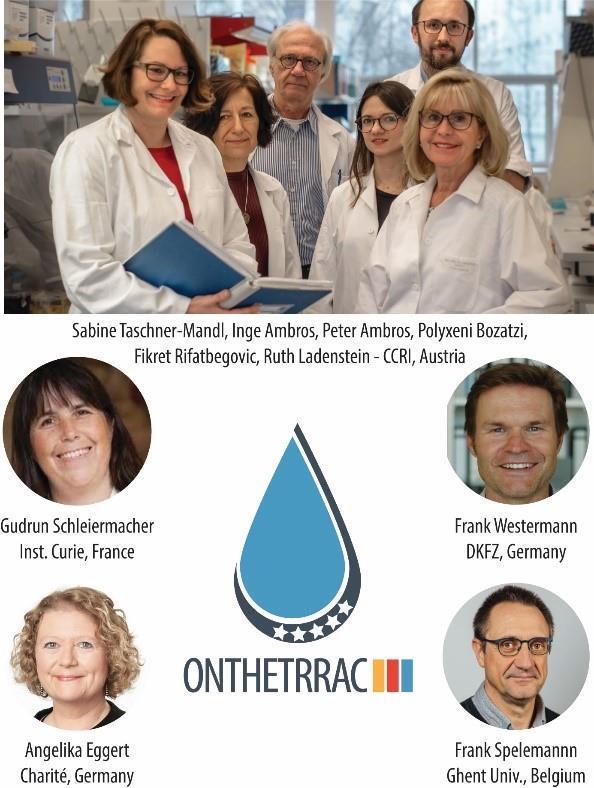Overview
ONTHETRRAC has uncovered new aspects of tumor heterogeneity in the childhood cancer neuroblastoma, that are important for accurate diagnosis, prognosis and for overcoming treatment resistance.
This collaborative transnational project under the leadership of Dres. Inge and Peter Ambros and Dr. Sabine Taschner-Mandl, CCRI, St. Anna Children’s Cancer Research Institute, Vienna, together with research partners from the Charité Berlin, the Institut Curie in Paris, the University of Ghent and the German Cancer Research Center in Heidelberg allowed insights into the role of tumor cells and molecular markers in biopsies (solid and liquid), and provided clinical diagnostic tools and recommendations that are now implemented in the new European high-risk neuroblastoma trial protocol.
 ONTHETRRAC Consortium
ONTHETRRAC ConsortiumNeuroblastoma remains a deadly disease for 60% of high-risk patients. Existing molecular classifiers/drug targets stem from single biopsies of bulky tumors, but this simplified view of neuroblastoma homogeneity is inappropriate. Intra-tumor heterogeneity must be taken into account for predictive biomarker identification. ONTHETRRAC has assembled an international expert team in neuroblastoma molecular genetics and clinical research. The ONTHETRRAC team has invested cutting-edge omics and liquid biopsy technologies to develop strategies overcoming intra-tumor heterogeneity-based sampling inaccuracy and support in-depth analysis of clonal evolution of therapeutic targets and predictive biomarkers.
The research team has demonstrated genomic and proteomic heterogeneity between patients, within tumors and between tumor and relapse. Heterogeneous molecular markers and key oncogenic drivers of neuroblastoma, such as amplification of the MYCN gene, ALK alterations and mechanisms that enable the maintenance of telomers, the activation of telomerase as well as alternative lengthening of telomers (ALT) were found to be of prognostic relevance. ONTHETRRAC also provides clinically relevant recommendations on how to monitor disease course on the sub(clonal) level by circulating tumor DNA analysis in liquid biopsy of blood and bone marrow samples, taking spatial and temporal intra-tumoral heterogeneity into account.
The resulting diagnostics and monitoring guidelines now guide new targeted therapeutic interventions, e.g. ALK inhibitor treatment, in the next European high-risk and relapse neuroblastoma trial protocols to target the most aggressive and resistant tumor clones and to detect relapse early.
Interview
Meet Dr. Gerber, an early-career researcher involved in ONTHETRRAC project
Teresa Gerber carried out her PhD-thesis-related work at CCRI, St. Anna Children’s Cancer Research Institute and successfully completed her PhD in 2020.
She recently published a paper on the assessment of blood sample handling conditions for liquid biopsy analyses.
How do you think this project has advanced our knowledge about the disease?
Liquid biopsies are the analysis of molecular markers circulating in body fluids, such as peripheral blood. For example, DNA fragments released by tumor cells can be analyzed to gain genomic information from the tumor. Further, liquid biopsies can be used to track genomic markers at certain points to monitor the disease course.
In our study we provide blood sample handling guidelines for a harmonization of pre-analytical processes to ensure high sample qualities. These guidelines are highly relevant, because in multi-center studies, blood samples are sent between institutions within Europe to perform different analyses.
I have then focused on the investigation of how circulating genetic markers in blood and bone marrow change over time and how they compare to those found in the primary tumor.
Because of ONTHETRRAC we now know that analyzing only one tiny biopsy taken at the time point of diagnosis is not sufficient, because neuroblastoma is a highly heterogeneous disease. We also learned which genetic markers and/or therapeutic targets we need to capture with our diagnostic assays. And we found that liquid biopsy analyses can help to identify more aggressive, treatment-resistant subclones, track them and use this information for detecting relapse at an early time point.
What TRANSCAN-2 funding has meant to you to carry out this project?
TRANSCAN funding has enabled me to carry out my PhD at St. Anna Children’s Cancer Research Institute, embedded in the ONTHETRRAC consortium, a network of excellent European researchers. The funds also allowed me to participate in consortium meetings and international conferences, e.g. the `Advances in Neuroblastoma Research´ congress, where I presented my work and engaged in scientific discussions. This was important for my training as PhD student, but also for my current career in clinical research.
How has the transnational collaborative aspect of the project contributed to project success?
Pediatric cancers affect more than 100,000 patients a year in Europe, yet they are rare (some ultra-rare) diseases. Therefore, one reason why transnational collaboration is so important is because it enables us to collect a sufficient number of samples to draw statistically meaningful conclusions, for example about the prognostic relevance of even sub-clonal mutations. Thereby, we already established harmonized standards and implementation at the European level. Another reason why transnational collaboration is relevant: it enables the combination and efficient exchange of very specialized expertise. This is a prerequisite for high-quality research.
Any additional comments you would like to add?
I find it particularly encouraging that several members of the consortium (Charité, CCRI and Curie) together with other European partners will build on the network and findings obtained in ONTHETRRAC, in the scope of the project LIQUIDHOPE, which received funding under the TRANSCAN 2 initiative.